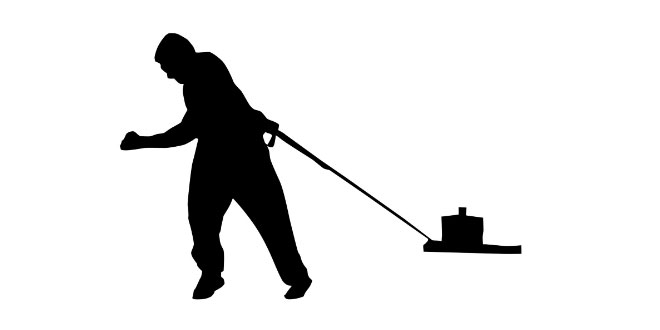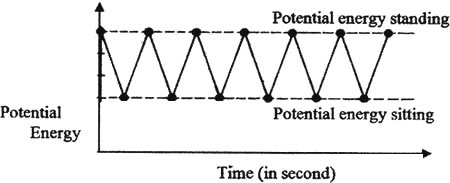Question: We wind our watch once a day, what happens to the energy?
Answer: When we wind our watch, we wind the spring inside the watch. As a result, energy is stored in the spring in the form of elastic potential energy. This elastic potential energy is used to make the watch work the whole day.
Question: What is the amount of work done by a force when a body moves in a circular path?
Answer: Work done is given by the expression W = FS cos θ. When a body moves in a circular path, then the displacement (S) is zero. Therefore, work done is W = F x 0 = 0.
Question: Look at the activities listed below.
Reason out whether or not work is done in the light of your understanding of the term ‘work’
- Suma is swimming in a pond.
- A donkey is carrying a load on its back.
- A wind-mill is filling water from a well.
- A green plant is carrying out photosynthesis.
- An engine is pulling a train.
- Food grains are getting dried in the sun.
- A sailboat is moving due to wind energy.
Answer:
- Work is done because the displacement of swimmer takes place in the direction of applied force.
- If the donkey is not moving, no work is done as the displacement of load does not take place in the direction of applied force.
- Work is done, as the displacement takes place in the direction of force.
- No work is done, because no displacement takes place.
- Work is done, because displacement takes place in the direction of applied force.
- No work is done, because displacement does not take place.
- Work is done because displacement takes place in the direction of the force.
Question: Illustrate the law of conservation of energy by discussing the energy changes which occur when we draw a pendulum bob to one side and allow it to oscillate. Why does the bob eventually come to rest ? What happens to its energy eventually ? Is it a violation of the law of conservation of energy ?
Answer: When the pendulum bob is pulled (say towards left), the energy supplied is stored in it is the form of PE on account of its higher position. When the pendulum is released so that it stars moving towards right, then its PE changes into KE, such that in mean position, it has maximum KE, and zero PE. As the pendulum moves towards extreme right, its -KE changes into PE such that at the extreme position, of has maximum PE and zero KE. When it moves from this extreme position to mean position, its PE again changes to KE. This illustrates the law of conservation of energy. Eventually, the bob comes to rest, because during each oscillation a part of the energy possessed by it transferred to air and- m overcoming friction at the point of suspension. Thus, the energy of the pendulum is dissipated in air.
The law of conservation of energy is not violated because the energy merely changes its form and is not destroyed.
Question: In each of the following a force, F is acting on an object of mass, m. The direction of displacement is from west to east shown by the longer arrow. Observe the diagrams carefully and state whether the work done by the force is negative, positive or zero.
Answer:
In case of fig. (a), W = 0, because the force acts perpendicular to the direction of displacement.
In case of fig. (b) W = positive, because the force acts in the direction of displacement.
In case of fig. (c) W = negative, because the force acts in the direction opposite to the displacement.
Question: Distinguish between work, energy and power. State the SI units for each of these quantities.
Answer:
- Work: It is defined as the product of force applied and the distance moved by the body on the application of the force. In SI it is measured in joule.
- Energy: It is defined as the capacity of a body to do work. In SI it is measured in joule.
- Power: It is defined as the rate of doing work. It measures how fast or slow the work is done. In SI it is measured in watt.
Question: A girl sits and stands repeatedly for 5 minutes. Draw a graph to show variation of potential energy with time.
Answer:
 Class Notes NCERT Solutions for CBSE Students
Class Notes NCERT Solutions for CBSE Students





